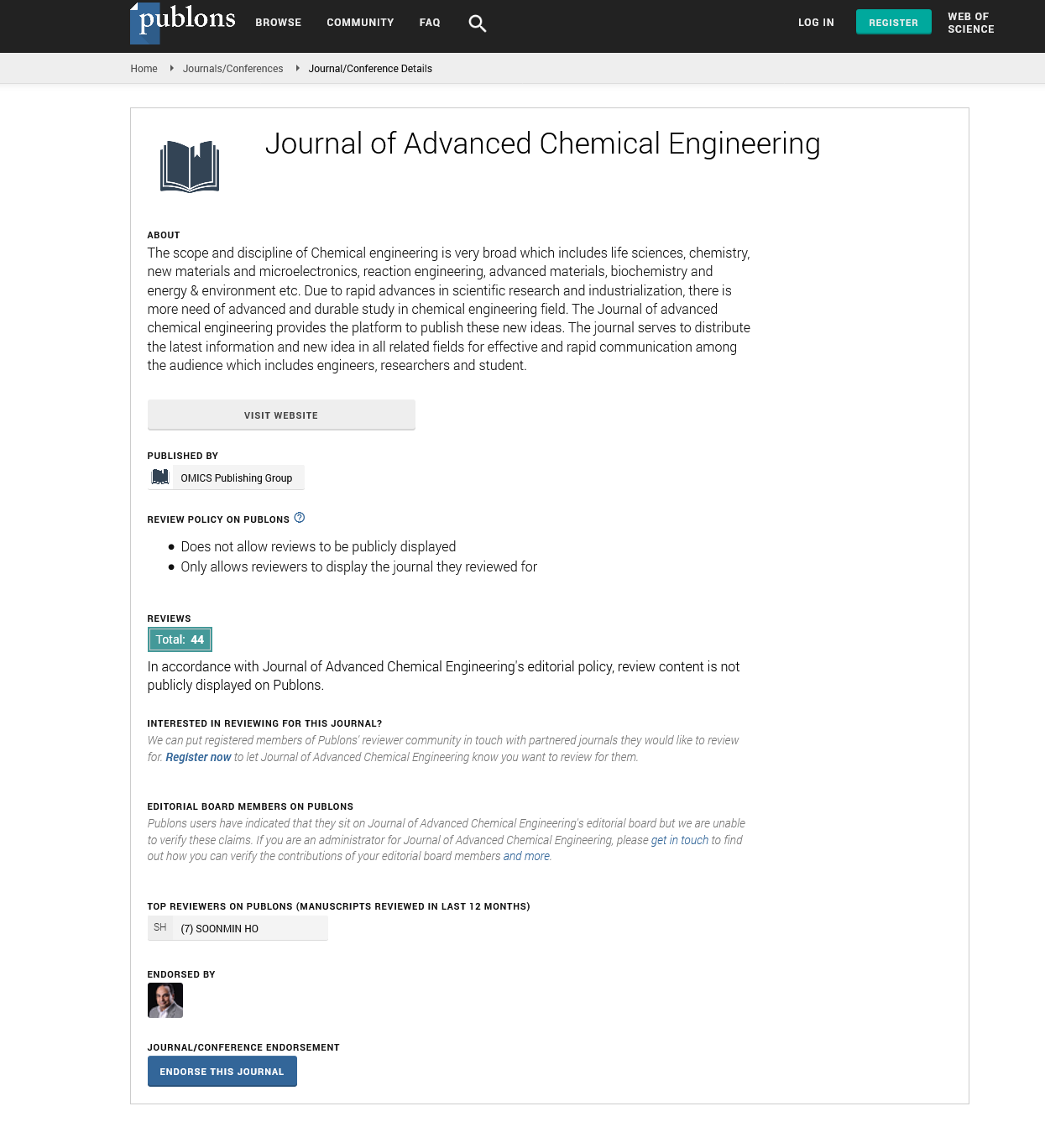Indexed In
- Open J Gate
- Genamics JournalSeek
- Smithers Rapra
- RefSeek
- Directory of Research Journal Indexing (DRJI)
- Hamdard University
- EBSCO A-Z
- OCLC- WorldCat
- Scholarsteer
- Publons
- Geneva Foundation for Medical Education and Research
- Google Scholar
Useful Links
Share This Page
Journal Flyer

Open Access Journals
- Agri and Aquaculture
- Biochemistry
- Bioinformatics & Systems Biology
- Business & Management
- Chemistry
- Clinical Sciences
- Engineering
- Food & Nutrition
- General Science
- Genetics & Molecular Biology
- Immunology & Microbiology
- Medical Sciences
- Neuroscience & Psychology
- Nursing & Health Care
- Pharmaceutical Sciences
Perspective - (2022) Volume 12, Issue 11
Inorganic Polymer Technology in Synthetic Chemistry
Lukey Jawed*Received: 04-Nov-2022, Manuscript No. JACE-22-19149; Editor assigned: 08-Nov-2022, Pre QC No. JACE-22-19149 (PQ); Reviewed: 24-Nov-2022, QC No. JACE-22-19149; Revised: 30-Nov-2022, Manuscript No. JACE-22-19149 (R); Published: 08-Dec-2022, DOI: 10.35248/2090-4568.22.12.260
Description
Synthetic chemistry is central to modern chemistry. It provides chemists with the most powerful means of constructing the material foundation for the imagined world. Its primary goal is to create a wide range of compounds, phases, materials, and ordered chemical systems required by today's rapidly advancing society, going far beyond simply discovering and synthesising naturally occurring compounds. In recent history, these compounds have served as the foundation for numerous scientific and technological advances. These advancements have resulted in an increase in the demand for new materials with specific structures and functions, posing both challenges and opportunities for synthetic chemists. Synthetic chemistry advances have frequently been the driving force behind industrial revolutions and the birth of new science and technologies [1].
Another field in which synthetic chemistry has played critical roles is medicine. Outstanding examples since the mid-twentieth century include the successful syntheses of SAS drugs, penicillin, a variety of antibiotics, and other medicines, which have significantly improved and continue to improve overall abilities in treating and combating human diseases. Many recent industrial and agricultural advances have been made possible by the ability to produce the three major classes of synthetic materials, namely synthetic fibre, synthetic plastic, and synthetic rubber. There is no doubt that synthetic chemistry has made significant contributions to improving human society's living conditions [2].
Continuous flow chemistry is a process intensification technology that provides significant advantages over traditional inorganic synthesis in one-pot solution processing conditions. The application of continuous flow chemistry in the separation and extraction of inorganic compounds, as well as the synthesis of metal-organic frameworks and polyoxometalates, is summarised in this review.
Continuous flow chemistry is a process intensification technology that provides significant advantages over traditional inorganic synthesis in one-pot solution processing conditions. The application of continuous flow chemistry in the separation and extraction of inorganic compounds, as well as the synthesis of metal-organic frameworks and polyoxometalates, is summarised in this review.
It is possible to create solvent extraction systems with high performance and speed in a microchannel that do not require any mechanical shaking, mixing, or stirring. As a result, flow chemistry can be used in liquid-liquid extraction to effectively separate and extract products, allowing the mechanism of the two-phase reaction to be investigated [3].
Technology based on inorganic polymers
Inorganic polymer concretes, also known as 'geopolymers,' have emerged as novel engineering materials with the potential to play a significant role in an environmentally sustainable construction and building products industry [4].
These materials, which are commonly formed by alkali activation of industrial aluminosilicate waste materials such as coal ash and blast furnace slag, have a very small Greenhouse footprint when compared to traditional concretes, as will be discussed in detail in this paper. Geopolymeric materials derived from coal ash (Class F and/or Class C) can outperform Ordinary Portland Cement (OPC) in terms of chemical and mechanical properties while remaining highly cost effective. The robustness and versatility of the manufacturing process is a key feature of geopolymer technology; it allows products to be tailor-made from a variety of coal ash sources and other aluminosilicate raw materials to have specific properties for a given application at a competitive cost. At the moment, applications of particular interest include low or high strength concretes with good chloride penetration resistance, fire and/or acid resistant coatings, and waste immobilisation solutions for the chemical and nuclear industries [5].
Conclusion
To develop a geopolymer industry, the technical virtues of the technology must be "de-risked," and the commercial and environmental value of the technology must be quantified so that it can be accurately incorporated into the value proposition. This can be accomplished through more open dialogue between academia and industry, as well as greater dissemination of basic knowledge. The single most significant barrier to the emerging geopolymer industry's use as a load-bearing material in the construction industry is not technological, but rather regulatory.
References
- Forrest CB, Chesley Jr FD, Tregear ML, Mistry KB. Development of the learning health system researcher core competencies. Health Serv Res. 2018; 53(4):2615-2632.
[Crossref] [Google Scholar] [PubMed]
- Bodenheimer T, Sinsky C. From triple to quadruple aim: care of the patient requires care of the provider. Ann Fam Med. 2014; 12(6):573-576.
[Crossref] [Google Scholar] [PubMed]
- Fiscella K, Carroll JK. Re: how evolving United States payment models influence primary care and its impact on the quadruple aim: the need for health equity. J Am Board Fam Med. 2019; 32(1):118.
[Crossref] [Google Scholar] [PubMed]
- Morris ZS, Wooding S, Grant J. The answer is 17 years, what is the question: understanding time lags in translational research. J R Soc Med. 2011; 104(12):510-520.
[Crossref] [Google Scholar] [PubMed]
- Bentley TG, Effros RM, Palar K, Keeler EB. Waste in the US health care system: a conceptual framework. Milbank Q. 2008; 86(4):629-659.
[Crossref] [Google Scholar] [PubMed]
Citation: Jawed L (2022) Inorganic Polymer Technology in Synthetic Chemistry. Adv Chem Eng.12:260.
Copyright: © 2022 Jawed L. This is an open-access article distributed under the terms of the Creative Commons Attribution License, which permits unrestricted use, distribution, and reproduction in any medium, provided the original author and source are credited.

